How To Get Texture Packs For Minecraft
![]()
Contents
- 1 Preface
- 1.1 What NOT to do
- 2 Getting Started
- 2.1 Making a Resource Pack
- 2.2 Tools
- 2.2.1 File Archiver
- 2.2.2 IDE
- 2.2.3 Audio Editor
- 2.2.4 Image Editor/3D Modeling Tool
- 3 Creating a resource pack
- 3.1 Creating the Folder
- 3.2 Creating a .MCMETA file
- 3.3 Formatting pack.mcmeta
- 3.3.1 "pack_format"
- 3.3.1.1 "description"
- 3.3.1.2 Correct syntax
- 3.3.1 "pack_format"
- 3.4 Testing your Pack
- 3.4.1 Troubleshooting
- 3.5 Pack icon
- 4 Adding content
- 4.1 Structuring the assets folder
- 4.1.1 Adding a namespace folder
- 4.2 Accessing the vanilla resources
- 4.3 Modifying an Entity's texture
- 4.3.1 Finding the vanilla texture
- 4.3.1.1 Pack Hierarchy
- 4.3.1 Finding the vanilla texture
- 4.4 Modeling Blocks/Items
- 4.4.1 Replacing a Block
- 4.4.2 Modeling the Ladder - Blockbench
- 4.4.3 Texturing the Ladder - Paint.net
- 4.4.4 Finishing off
- 4.5 Changing existing sounds or music
- 4.5.1 Finding a sound's path
- 4.5.2 Modifying the sound
- 4.5.3 Testing your sound
- 4.6 Adding new sounds or music
- 4.6.1 Finding the sound path
- 4.6.2 Adding the folders and sound in your resource pack
- 4.6.3 Changing the sound event
- 4.6.4 Testing your sound
- 4.7 Adding Languages
- 4.8 Animation Properties
- 4.9 Texture Properties
- 4.10 Fonts
- 4.1 Structuring the assets folder
- 5 Testing your Resource Pack
- 6 Packaging Resource Packs with Worlds
- 7 Server Resource Packs
- 8 References
Preface [ ]
Resource packs allow users to include files that can modify or add custom textures, models, animations, music, sounds, user interfaces, and languages that change the way some things in Minecraft behave or look.
What NOT to do [ ]
There are some things that you should NOT do when creating a resource pack / texture packs, which includes but is not limited to:
- Anything that violates the Minecraft EULA.
- Release files that allow users to play a release of Minecraft without having purchased it from Mojang.
- Release the decompiled source code of Minecraft in any way.
In any case, you should always follow the Terms and Conditions on the Mojang Studios website.
It is also suggested that you never extract game files to your desktop, as it can result in technical issues.
Getting Started [ ]
Making a Resource Pack [ ]
Minecraft has a unique mechanic that allows for text and media files to be added to the game files that allow for everything from custom block textures and models to custom credits and sound events. This tutorial is meant to help with setting up the file systems in order to implement them. Since the files are essentially code, there are technical rules for how to format files and certain things may change from version to version. As such, what is written in this tutorial may not apply to every situation, but in the case where the difference is significant and specific, it will provide a framework on the changes needed for different versions.
This tutorial is geared toward the latest release of Minecraft, which is currently 1.17
{ "pack": { "pack_format": 7, "description": "My Resource Pack" }, "language": { "LANG_COUNTRY": { "name": "My Custom Language", "region": "Country/Region name", "bidirectional": false 253 } 252 } 251} Tools [ ]
Creating custom files for Minecraft, whether in the forms of resource/data packs or mods, is somewhat technical and can be difficult. There are many rules that must be followed in order for add-ons to work correctly, most notably how the files are formatted. There are many tools that can help mitigate these issues, some of which are listed here.
File Archiver [ ]
To access the base assets of Minecraft to edit textures, models, or sounds, a file archiver is needed. 7-Zip or WinRAR are suggested. MacOS has a built-in file archiver called "Archive Utility" that can be used, but if an alternative is wanted, The Unarchiver will do.
IDE [ ]
Making a resource pack involves creating JSON text files, which can be tricky to use and format correctly. Many IDEs (Integrated Development Environment) assist with formatting these files and making sure proper syntax is used, as well as help organizing files in a project. Here are some suggestions:
- Notepad++ - A very lightweight IDE. very easy to use
- Atom – Suggested for those new to IDEs. Very easy to set up a project folder and stay organized.
- Visual Studio Code – More complex IDE better suited for those who have experience with working in IDEs.
- jsonformatter.org - an online JSON formatting
Audio Editor [ ]
In order to add sound files, you must put it in the proper format (.ogg). While this can be done using one of numerous sites online, an audio editor program is suggested to allow customizing or trimming of audio files. Audacity is one of the most popular audio editors.
Image Editor/3D Modeling Tool [ ]
To add textures or custom models, it is suggested to use a modeling program that allows for a visual-based editing system. Like with audio conversion websites, there are many online tools, though a common recommended program is Blockbench. Most image editors will suffice to modify textures, but it is recommended to use an editor that supports transparency such as paint.net or https://pixlr.com/ so that you may add transparent pixels to textures.
Creating a resource pack [ ]
All the resources and instructions in a pack reside in the pack folder, which lives in the "resourcepacks" directory. You may wish to use an IDE to help keep track of the files within your resource pack if there are multiple.
In versions 1.11 and higher, all file names within a resource pack should use lowercase letters only.
Creating the Folder [ ]
The first thing we need to do is create the folder that will contain all the resource pack files. Create a folder on your desktop or another easily accessible location and name it Tutorial_Resource_Pack. This will eventually be the name displayed in the resource pack menu.
Creating a .MCMETA file [ ]
Within your resource pack folder, we need to create a pack.mcmeta file. This lets Minecraft know that the folder is a resource pack and contains useful information such as:
- The recommended version for the resource pack.
- The description displayed under the pack title in the selection menu.
- Preliminary information on any custom languages added in the resource pack.
To create this file, we need to create a text file within the folder and name it pack.mcmeta . Make sure the file extension is .mcmeta and not .txt or the pack may not be detected. When renaming you may get a warning that changing a file name extension could make the file unusable or may switch the program required to open it. You can still open this file in a text editor by right-clicking the file and selecting the "Open With" option. Note: You may need to select a program using your file browser.
Formatting pack.mcmeta [ ]
Open pack.mcmeta in a text editor or IDE of your choice and type or copy+paste the following:
{ "pack" : { "pack_format" : 7 , "description" : "Tutorial Resource Pack" } }
"pack_format" [ ]
The value of "pack_format" tells Minecraft what release the resource pack is designed for, and is different for certain versions. The following list what versions each value is associated with:
-
1for versions 1.6.1 – 1.8.9 -
2for versions 1.9 – 1.10.2 -
3for versions 1.11 – 1.12.2 -
4for versions 1.13 – 1.14.4 -
5for versions 1.15 – 1.16.1 -
6for versions 1.16.2 – 1.16.5 -
7for versions 1.17.x -
8for 1.18 snapshots
Note: As more updates are released, values may be changed or added.
"description" [ ]
The text following "description" is displayed under the pack title in the selection menu, and must be put inside quotes "". If you wish to use special characters, you can enter the Unicode code for the character in the format \u####, where #### is the Unicode hex code for the character. Say you want to use the letter Þ (Thorn), which has code U+00DE. Inside the description you would type \u00DE. Make sure that you are using the correct slash, or it may not work. A list of Unicode codes can be found here. Note: Only the characters 0000–FFFF (Basic Multilingual Plane) are supported. [ citation needed ]
Correct syntax [ ]
Be very careful not to forget quotation marks "", colons :, braces {}, or square brackets []. Missing one of these can lead to your resource pack not being detected by Minecraft. Make sure that your pack.mcmeta file matches the one shown above.
Testing your Pack [ ]
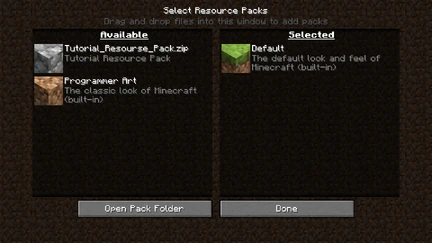
If your resource pack is formatted correctly, it should appear in the selection menu like this.
At this point, you can test if the pack is formatted correctly by putting it in the game! To do this you must place your resource pack folder in the Minecraft pack folder. You can access it by selecting "Options", then "Resource Packs", then "Open Pack Folder", or you can navigate to it from your file browser:
- For Windows, right click on the start button → run → type in %appdata% → .minecraft → resourcepacks
- For MacOS, go to Library → Application Support → minecraft → resourcepacks
- For Linux, go to ~/.minecraft/resourcepacks (/home/<username>/.minecraft/resourcepacks)
Once you have the folder open, you can drag your custom pack folder and drop it in.
If you have formatted the files correctly, you should see your resource pack appear in the menu.
Troubleshooting [ ]
If you don't see your pack in the list, make sure your pack.mcmeta file is correct and saved in the folder. Look for any missing braces {}, commas ,, colons :, quotation marks "", or square brackets []. Remember that for each open brace, quotation, or square bracket, you must have a closing brace, quotation, or square bracket.
Pack icon [ ]
If an icon is not specified, a cobblestone icon will show up next to the pack. If you want to use your own pack icon, you can place it inside your resource pack folder with the name pack.png. The file must be a PNG, and works with any square resolution, but a 128x128 pixel image renders the best.
Adding content [ ]
Structuring the assets folder [ ]
Now that you have your resource pack set up, you can start adding content to it. Most files you add will be in a subfolder called assets. Simply create a new folder inside your resource pack folder named assets. This, pack.mcmeta, and pack.png should be the only files located directly in your parent resource pack folder. Any other resource files must be located somewhere in assets or they won't be read by Minecraft.
Adding a namespace folder [ ]
Next, inside your assets folder are your namespace folders. These help separate the files in your resource pack so that there is no confusion between which files are located where. If you plan on modifying or replacing vanilla resources, those files would go into the minecraft namespace folder. Custom additions should go in your own namespace folder, which for this tutorial will be named custom. In the future, you should use a significant or unique namespace so that there isn't a possibility of other resource packs confusing which files belong where when multiple packs are loaded.
Accessing the vanilla resources [ ]
If you plan on editing multiple resources, or to help ease of access, you may want to save a copy of the vanilla resources in an accessible location in case some things rely on other files within the directory. To do this, you need to navigate to the vanilla resources file by opening the versions folder inside the .minecraft directory. You should see a list of numbered folders, which correspond to versions that you've loaded or used in the past. Open the folder corresponding to the version you want for your resource pack (in this tutorial it would be 1.17) and extract the JAR file located inside, which can be done by right clicking the file and selecting a file archiver from the "Open With" option. You may want to save this in an accessible location for future reference, as certain tasks such as modifying block models require textures in addition to the model files. If you do not have a program that can open .jar files simply change the extension from .jar to .zip.
Modifying an Entity's texture [ ]
This section goes through the process of modifying a texture, using the creeper texture as an example.
Finding the vanilla texture [ ]
First, you will need the vanilla resource to get the texture you want to edit. This will be located in the extracted version folder that was created in the previous section. In the extracted folder, navigate to assets→minecraft→textures→entity→creeper where you will find creeper.png. Save a duplicate of this file somewhere accessible or keep the folder window open during the next few steps.
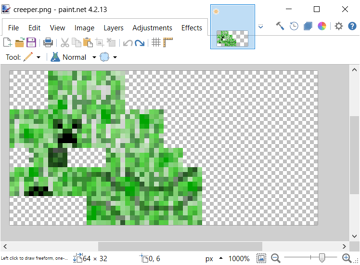
The creeper texture loaded in paint.net
Next you'll need to replicate the folder structure of the vanilla pack within your resource pack, which lets Minecraft know to use the texture. Since we are modifying a default texture, this will be in the minecraft subfolder of our assets folder. Within the minecraft folder of your resource pack, do the following:
- Inside
minecraft, create a folder calledtextures. - Inside
textures, create a folder calledentity. - Inside
entity, create a folder calledcreeper. - Copy the creeper texture from the vanilla resource pack into your newly created
creeperfolder.
Now that you have the normal creeper texture placed in your resource pack, open it up in the image editor of your choice. It should look something like the image shown.
Since texture files are very small, you may need to zoom in.
- A quick note on textures
If you've never seen a texture before, the above image might surprise you. A lot of textures look this way and are "wrapped" around a model, like wrapping paper around a present.
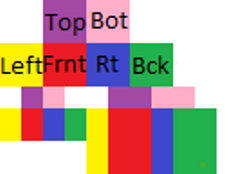
Color-coded Texture. Sections of the same color will always face the same direction.
Now it's time to be creative! Edit the texture however you want. For simplicity, this example adds a headband. Note where the changes are and compare it to the color-coded texture above.
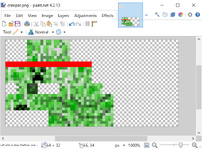
Creeper texture with a red headband.
Once you are happy with your texture, save the file as creeper.png. It is important that it is saved with the same name as the default asset or otherwise it will not detect and load your texture.
Now you can load up Minecraft and spawn a creeper with your custom texture! If it doesn't show up, make sure that you've selected your resource pack. If it still doesn't work, make sure you've named the file properly and placed it in the correct folder.
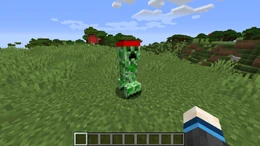
Here's the creeper with the new texture as it appears in-game.
Pack Hierarchy [ ]
If you are playing with multiple resource packs loaded, there may be some textures that are in your pack that aren't being shown. This is because of the way resource packs are loaded in Minecraft. All selected resource pack files are loaded from the bottom up as they are shown in the selection menu, so if there is a resource pack that is loaded above yours, it may replace files that you've changed. This can cause various issues with using multiple themed resource packs that have differing textures.
Modeling Blocks/Items [ ]
Sometimes you may want to change one of the Minecraft models. To do so you will need a file archiver to get the default model and texture along with a 3D modeling tool to edit the model. Blockbench works well in this case since it can export directly to the .json format needed for models.
Replacing a Block [ ]
Because the default ladder in Minecraft isn't 3D, you can replace it with your own model. First, get all the ladder's files into this resource pack:
- Open the Minecraft JAR file using a ZIP viewer of your choice.
- Navigate into the
assets/minecraft/blockstatesfolder, then extractladder.jsontoTutorial_Resource_Pack/assets/minecraft/blockstates - Navigate into the
assets/minecraft/models/blockfolder, then extractladder.jsontoTutorial_Resource_Pack/assets/minecraft/models/block - Navigate into the
assets/minecraft/textures/itemfolder, then extractladder.jsontoTutorial_Resource_Pack/assets/minecraft/textures/item - Lastly, navigate into the
assets/minecraft/textures/blockfolder, then extractladder.pngtoTutorial_Resource_Pack/assets/minecraft/textures/block.
Now you can either edit the ladder.png using your preferred image editor, or you can edit it in your preferred modeling editor.
Note: If you are doing a basic "Just Simple Nonanimated Textures" pack, the .json files are unnecessary. If you are doing special features to change what the texture looks like when certain parameters are true or false. For example that resource pack that makes grass blocks smooth so you don't have dirt lines everywhere in your world that uses code.
Modeling the Ladder - Blockbench [ ]
In modeling the ladder, we will use Blockbench. Once you have opened the program, press Ctrl+O to open the model selection menu. After the open dialog has appeared, go to the location where you saved ladder.json and select .
You then should be facing a ladder that is on the south side of the box.
- On the menu bar, go to "Edit -> Add Cube" to create a new block.
- Resize the model to a full-sized cube. Then, under Textures on the left panel right click
ladder.png, then click Apply to Untextured Faces. - In the top left, there will be an image of the ladder, with a 1×1 highlighted region. Move this to change the texture to what you want it to be. Repeat until all sides of the block are as wanted.
- Go to "File -> Save Model" and save in
resourcepacks/Tutorial_Resource_Pack/assets/minecraft/models/block/ladder.json(Replace "block" with "blocks" for 1.12 and below).
Now we have created a new model for the ladder block in Blockbench.
Texturing the Ladder - Paint.net [ ]
Go to getpaint.net and get paint.net or go to ninite.com, select paintNET and run it after it downloads to install paint.net for free.
- Open paint.net.
- Do Ctrl+O and go to .minecraft/textures/block/ladder.png and double click.
- Edit the Ladder however you want.
- When you're done, press the X button in the top right of the window. It will open a dialog if you changed anything and ask if you want to save your work. Press Save then okay twice. You don't need to change anything in the menus.
Finishing off [ ]
When you have completed the 3D model of the ladder and saved it, launch Minecraft, and test it out. Place a ladder on a wall, and you should see its replaced model.
Changing existing sounds or music [ ]
This section is missing information about Changing subtitles of sounds, adding subtitles to existing sounds without them.
Please expand the section to include this information. Further details may exist on the talk page.
Just like modifying the default textures or models, you can substitute custom sounds in place of the default ones. In this example, you will learn how to change the boss music in the ender dragon fight.
Finding a sound's path [ ]
Similar to the custom texture and models, you'll first need to know the path of the sound you want to change.
- Inside your .minecraft folder, navigate to
assets/indexes, which will have a list of numbered.jsonfiles. - Find the
.jsonfile corresponding to your Minecraft version (e.g.1.16.json), and open it with a text editor or IDE. - In this file you can find all the sounds found in Minecraft. Press CTRL +F to search for your sound.
- For a list of filenames for music, you can check Music#List
- Your sound path will look something like this:
minecraft/sounds/music/game/end/boss.ogg
Modifying the sound [ ]
- Inside your resource pack folder, navigate to
assets/minecraft. - Create a new folder named
sounds. - Now inside your
soundsfolder, you need to create new folders depending on your sound's path. For example, if your path isminecraft/sounds/music/game/end/boss.ogg, you need to create the folderssounds/music/game/end. - In the last folder (in this example, it's
end) you can put in your new sound file. Make sure you named the file to the file that you're replacing, or in this example,boss.ogg.- Note that this file must be a
.oggfile. To convert your sound file to a.oggfile, you can use the free website Online-Convert.com
- Note that this file must be a
Testing your sound [ ]
If everything went according to plan, you have now replaced a sound in Minecraft. To test it:
- Make sure you have enabled your resource pack.
- If you already had Minecraft open with your resource pack enabled, you can press F3 +T to reload all resource packs.
- Use the
/playsoundcommand to play your sound. In our example, type:/playsound minecraft:music.dragon master @s
Adding new sounds or music [ ]
![]()
This section is a work in progress.
Please help in the expansion or creation of this article by expanding or improving it. The talk page may contain suggestions.
In addition to modifying default sounds, you can add your own! In this example, a new player hurt sound can be added without replacing any of the current player hurt sounds.
Finding the sound path [ ]
In order to add a sound, you'll need to know where it should actually go by determining its path. Unlike replacing sounds, you will go straight to your resource pack folder and search in there.
- Find and open your version's
.jsonindex file (e.g1.16.json) from.minecraft/assets/indexes. - Press CTRL +F to search for your sound path.
- In this case, the location for the player hurt sounds will look like this:
minecraft/sounds/damage/.
- In this case, the location for the player hurt sounds will look like this:
Adding the folders and sound in your resource pack [ ]
- Going to your resource pack folder, navigate to
Tutorial_Resource_Pack/assets/minecraft. - Inside the
minecraftfolder, create a folder namedsounds.- If you already have a
soundsfolder from replacing a default sound, open that folder.
- If you already have a
- Within the
soundsfolder, create a folder that matches the directory of the sound you want to add. In this case, we are going to create a file calleddamage. - Add your sound here.
- The sound must be a
.oggfile. Like in the previous section, you may use the free website Online-Convert.com or use Audacity as mentioned at the top of the page. - Also note the already existing files seen in your
.jsonfile from above. In this case, five other hurt sounds exist within theminecraft/sounds/damage/folder, two for falling at different heights (fallbig.oggandfallsmall.ogg) and the other three are when the player actually gets hurt (hit1.ogg,hit2.ogg, andhit3.ogg) Since we want to add a fourth sound to the existing three hurt sounds, we cannot reuse those file names. For simplicity, name your soundhit4.ogg.
- The sound must be a
Changing the sound event [ ]
Because we are adding a sound, we must change the associated sound event in sounds.json.
- Go back to
assets/minecraftin your resource pack folder. - Create a text file named
sounds.json. Do make sure that the file extension is indeed .json and nothing else. - At your choice, paste the following template into
sounds.json:
{ "entity.player.hurt" : { "sounds" : [ { "name" : "damage/hit1" }, { "name" : "damage/hit2" }, { "name" : "damage/hit3" }, { "name" : "damage/hit4" } ], "subtitle" : "Hurt" } }
- The above code only applies to this example, which adds a new damage sound. If you are changing a different sound event, replace
entity.player.hurtwith the sound event listed in the vanillasounds.jsonfile. - You can find out the id used by Minecraft for each sound folder. By using
/playsoundin-game, you can determine this id. In this case, using/playsound minecraft:entity.player.hurt master @swill confirm that the player's hurt sound is indeed classified asentity.player.hurt. - Make sure the name fields are in lowercase characters only. The names of your files should be in lowercase as well. Otherwise, the resource pack may fail to use your new sounds.
- The
subtitlefield dictates the text that will display when the sound is played. It can either be a string of text, or can use a field defined in alangfile.[ needs testing ] - Correct
.jsonformatting is required! Any missing bracket, comma, etc. will result in the resource pack failing to work properly.
Testing your sound [ ]
If there is an error anywhere in your sounds.json file, none of the sounds described in it will appear in-game. If this happens, you should check the spelling and file paths.
If everything went according to plan, you have now added a sound to Minecraft. To test it:
- Make sure you have enabled your resource pack.
- If you already had Minecraft open with your resource pack enabled, you can press F3 +T to reload all resource packs.
- Use the
/playsoundcommand once again to play your sound. In our example, type:/playsound minecraft:entity.player.hurt master @s. For this example, it will likely require multiple tries, as hurt sounds are chosen randomly.
Adding Languages [ ]
You can add new languages to Minecraft using a resource pack. Assume your language code is 'LANG'[1] and country/region code is 'COUNTRY',[2] pack.mcmeta will look like:
- pack.mcmeta
{ "pack" : { "pack_format" : 7 , "description" : "Tutorial Resource Pack" }, "language" : { "LANG_COUNTRY" : { "name" : "Tutorial Language" , "region" : "COUNTRY/REGION NAME" , "bidirectional" : false } } }
If you want your language to be right-to-left, set "bidirectional" to true.
Then, put LANG_COUNTRY.json in assets/minecraft/lang inside your resource pack. When you launch the game, choose your resource pack, open the Language selection screen, and your new language will be there.
- Notes
The pack.mcmeta goes in the root folder of your resource pack, not in the assets/minecraft/lang folder. Also note that the above pack.mcmeta is the same file as the pack.mcmeta file that you have created a while ago. As of 1.7-pre, you can choose multiple resource packs at once. If you want to use your new language and resource pack for before 1.7, you need to combine them manually because multiple resource packs could not be selected before the version.
Animation Properties [ ]
An example of an animation file is this:
- stone.png.mcmeta
{ "animation" : { "interpolate" : true , "width" : 1 , "height" : 7 , "frametime" : 1 , "frames" : [ { "index" : 0 , "time" : 0 }, 1 , 2 , 3 , 4 , 5 , 6 , 4 , 2 ] } }
- Note
All you really need to make a texture animated is the following code. By default, it will make each frame last only one tick:
- stone.png.mcmeta
Save the file as the same name as the texture you want to be animated with an .mcmeta in the same folder as your texture.
Texture Properties [ ]
An example of a texture property is this:
- shadow.png.mcmeta
{ "texture" : { "blur" : false , "clamp" : true } }
Fonts [ ]
Character sizes in fonts are determined by the last line of pixels that contains pixels that contain a non-zero alpha. This allows additional padding to be added around characters by adding a color with an alpha level of 1, which Minecraft will consider as part of the character.
Testing your Resource Pack [ ]
- Launch the game
- Click on Options
- Click on Resource Packs
- Find "Tutorial_Resource_Pack" in the list on the left and click the arrow next to it
- Click Done
If you decide you want to make some changes to your resource pack, edit your resource pack, go to resource packs in options, remove your pack from the active list and exit, go back, and reapply it. Alternatively, saving the texture to the resource pack and pressing F3 +T will reload the pack without the need to reload the default textures first.
Packaging Resource Packs with Worlds [ ]
For use in singleplayer worlds, you can package your resource pack as a ZIP file named resources.zip inside the world directory. This will then be automatically used when playing the singleplayer world.
Server Resource Packs [ ]
If you are the owner of a server, you may set it as the resource pack of your server.
- Make sure your pack format is a .zip-folder.
- Upload the pack on a file hosting website, e.g. MCPacks.
- Copy the download link of your pack. IMPORTANT: If you are using your own server or some other host then you have to make sure that you are using a direct download link. You also need to make sure to use a SSL certificate that is compatible with the shipped Java version 8 u51. (MC-143768)
- Open the server.properties with a text editor.
- Search for the line "resource-pack=".
- Paste the download link after the equal sign.
- Optional: Set the "resource-pack-sha1" hash sum of the pack file.
- Save your changes to the server-properties and restart your server.
- Enjoy!
Servers can have an icon that will show up in the Multiplayer list.
- Create a PNG image with a size of 64 by 64 pixels, transparency is supported.
- Save (or rename) it to
server-icon.png. - Move it to the server's directory.
- Restart the server.
- Server icons will display next to the server name.
References [ ]
- ↑ ISO 639
- ↑ ISO 3166-1
How To Get Texture Packs For Minecraft
Source: https://minecraft.fandom.com/wiki/Tutorials/Creating_a_resource_pack
Posted by: swinforddreatenty.blogspot.com

0 Response to "How To Get Texture Packs For Minecraft"
Post a Comment